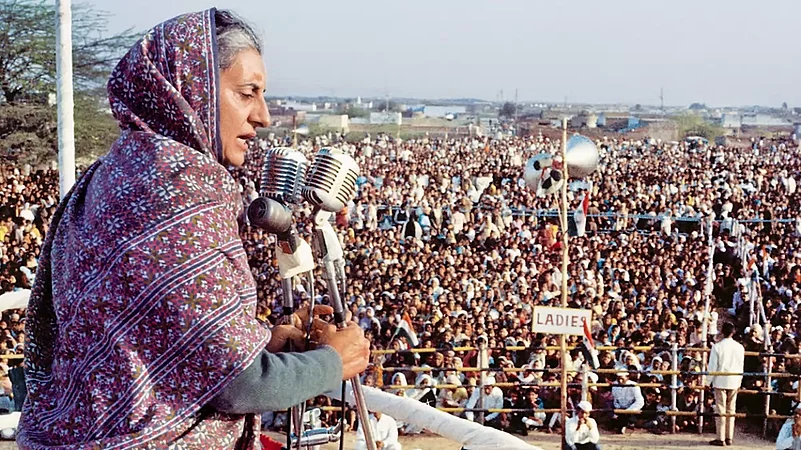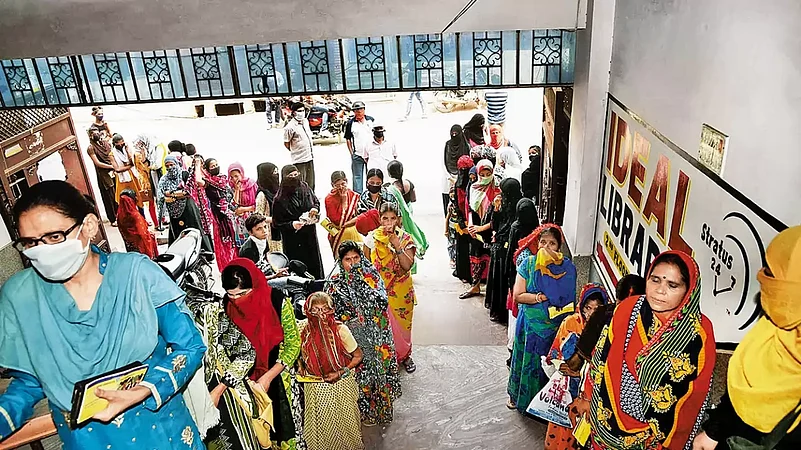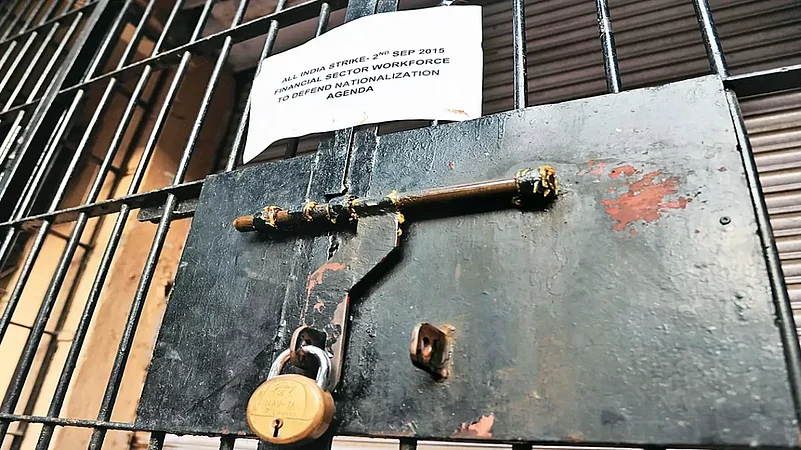On July 16, 1969, Prime Minister Mrs Indira Gandhi asked her core team to finalise the modalities about nationalisation of private banks. Before they could perhaps even inform her that it might require at least six months, she announced the nationalisation of 14 banks on All India Radio three days later on July 19.
The country’s economic policy came full circle when Finance Minister Nirmala Sitharaman announced in her 2021–22 budget speech the government’s decision to put IDBI Bank, two public sector banks (PSBs) and a general insurance company under the hammer. Last week, the Union government invited bids for IDBI Bank.
Decades after Indira Gandhi’s move, a volume of the Reserve Bank of India’s official history termed the bank nationalisation the “single most important economic decision” taken by any government since 1947. Let us see the space the privatisation of banks finds in India’s economic history.
India has had a chequered history of privatisation, with the very term denoting a range of reactions from buoyancy to discomfort and suspicion. Popular perception often finds it abominable to sell the “family silver”, and hence various governments instead prefer to call it “strategic disinvestment” like sugar coating the bitter pill. In its 1993 report on disinvestment, the C. Rangarajan Committee had recommended aggressive disinvestment, including 100 percent sale of stakes in several Public Sector Undertakings (PSUs).

Significantly, though the P.V. Narasimha Rao government liberalised the economy, the bulk of privatisation has occurred under the rule of the ‘nationalist’ party, with the Narendra Modi government furthering the programme initiated by the Atal Bihari Vajpayee government, which created a Department of Disinvestment in December 1999. The department was scaled up to become a full-fledged ministry in 2001. Several PSUs were privatised, but the process was stalled during 2004–14, as the UPA government gave greater autonomy to profit-making companies and tried to revamp sick units.
The Modi government cautiously moved in the first term, selling only minority stakes in some PSUs. But soon into the second term, it approved the strategic disinvestment of the entire shareholding in the Maharatna company Bharat Petroleum Corporation Ltd. (BPCL) in November 2019. Not a sick unit, BPCL was among the few PSUs listed in the Fortune 500. Indian policy on privatisation had taken a decisive turn.
The government also announced the proposed disinvestment of several major companies including Shipping Corporation of India, Minerals & Metals Trading Corporation, National Mineral Development Corporation and Bharat Heavy Electricals Ltd. In her landmark budget speech, Sitharaman also stated that while the government would just have a minimum presence in four strategic areas, including atomic energy, petroleum, minerals, banking and insurance, the CPSEs in non-strategic sectors would be privatised or closed down. Effectively, almost all the government utilities could now be sold, except regulatory authorities, autonomous organisations and a few others. The government also announced an increase in the Foreign Direct Investment (FDI) limit from 49 per cent to 74 per cent in the insurance sector, besides allowing foreign ownership.
The move invited immediate criticism, not only from the opposition parties but also from the RSS-affiliated organisation Swadeshi Jagran Manch (SJM), which strongly spoke against the privatisation of banks and proposed disinvestment of these companies. Terming it a “cause of major concern,” SJM’s National Co-Convenor Ashwani Mahajan had then asked the government to “reconsider this decision’’.
***
To understand the policy and its politics, one can turn to a brief history of nationalisation and privatisation. In the middle of the last century, many developing and newly independent countries believed that government control was required to protect the interests of the poor and to prevent a select few from taking over the economy. For the first several decades of the Republic, India nationalised a slew of companies ranging from airlines, banks, insurance and coal to oil companies. The trend was witnessed in several other developing countries as well.

However, over the years many of these PSUs came to incur heavy losses, became centres of inefficiency, caused a serious fiscal burden and came to represent the worst face of the government in business. Sudhir Naib in his book, Privatisation in India: Journey and Challenges, analyses official data and notes that with just five central government-controlled enterprises in 1951, the number grew to 249 in 2019, of which the top 10 earned a net profit of Rs 107,947 crore, 61.83 per cent of the total profit. The top 10 loss-making enterprises made a net loss of Rs 29,751 crore, over 94 per cent of the total loss. Together, these companies reported a net profit of Rs 142,952 crore in 2019.
The major thrust to privatisation came in the era of neoliberalism in the 1980s, led by the British Prime Minister Margaret Thatcher, who also formed a great friendship with Mikhail Gorbachev. The Cold War was over in a few years. The biggest challenge to capitalism had disintegrated, and soon a policy argument emerged that saw privatisation gaining currency as a necessary step to ensure growth and strengthen the economy. In hindsight, it was perhaps more a political tool to entrench capital into various economies and make their
return to government regulation difficult.
The Union government’s stand on the issue was perhaps best articulated in the Economic Survey 2019–20. The chapter “Privatization and Wealth Creation” in the Survey begins with a quote of Thatcher that “free enterprise” is an essential component of “freedom”. The document strongly advocated for overall privatisation and underlined that the 11 CPSEs, which saw strategic disinvestment from 1999 to 2004, performed better after the change in ownership.
***
But unregulated privatisation also leads to oligarchy and entrenched inequality. In the last decade, the French economist Thomas Piketty has upended existing notions about private capital with a series of stunning publications. He points out that inequality is a primary feature of capitalism and needs to be checked through state intervention.

Though the era of privatisation from 1980 onwards is bandied about to be of global prosperity, Piketty proves the theory wrong. In his seminal work, Capital and Ideology, he shows that “inequality has increased in nearly every region of the world since 1980”, and the “
regions that enjoyed a phase of relative equality between 1950 and 1980 are moving back toward the inegalitarian frontier”. As post-Communist Russia turned into “a society of oligarchs”, it witnessed unprecedented development in just a decade, as its society moved from high levels of monetary equality to “one of the most inegalitarian countries in the world” in less than 10 years from 1990–2000.
The situation is not dissimilar in India. Various reports have indicated that monetary inequality has increased during the pandemic, as the top 10 per cent Indians hold over 72 per cent of the country’s wealth. According to the Hurun Global Rich List, 40 more Indians became billionaires in the pandemic year 2020, taking the total number to 177. The head of Reliance Industries saw a jump of 24 per cent in his wealth and Gautam Adani doubled his wealth to $32 billion in 2020.
So, what is the best policy option for India? The answer lies in the choice of both the PSU and the manner of privatising it. Any blanket case for privatisation ignores the interests of society. “We are not opposed to privatisation, but we have to go case by case,” says Mahajan.
Sick and unwieldy PSUs can be privatised after protecting their employees’ interests, but PSBs and insurance companies are not the institutions of lending and deposits alone. Carriers of several government schemes, the PSBs have a phenomenal reach in rural areas, in terms of branches and ATMs. They meet the demands of the rural population and agriculture sector, which is not often lucrative and hence overlooked by private banks. In fact, several of the Modi government schemes like the Pradhan Mantri Jan Dhan Yojana received success solely due to the penetration of PSBs have across the country.
Speaking to Outlook, Mahajan puts it succinctly, “Financial and insurance sectors are strategic ones, and must not go to foreign hands. Privatisation of banks is not a good policy. They ensure the success of government schemes. Over 90 per cent of Jan Dhan accounts are with PSBs. DBT (Direct Benefit Transfer) schemes are successful largely due to such banks. It has also saved government money.”
World Bank Group President David Malpass said last week, “Helped by digital cash transfers, India managed to provide food or cash support to a remarkable 85 per cent of rural households and 69 per cent of urban households.” The question, then, is: who are the prime beneficiaries of the sale of public assets and who falls on the other side? And then one realises that the most worrying is privatisation by stealth, a situation when the government quietly withdraws from the social sector. Privatisation involves selling of public assets. But by spending less on health and education, the government pushes citizens to private players, bringing in the private sector by the back door. It leaves citizens vulnerable, particularly when the pandemic has emphasised the need to keep essential services beyond the purview of market forces. Of the 7 crore people who plunged into extreme poverty in 2020 due to the pandemic, a recent study by the World Bank says, a staggering 5.6 crore were Indians. As the adage goes, most Indians are just a medical bill away from poverty.
A recent report titled “National Health Accounts Estimates 2018–19” says that India’s total health expenditure went down from 3.9 per cent of the GDP in 2013–14 to 3.2 per cent in 2018–19. While the National Health Policy 2017 envisages the Union government health expenditure at 2.5 per cent of the GDP by 2025, the government’s expenditure went down to 1.28 per cent in 2018–19 from the previous year’s 1.35 per cent. Of India’s total health expenditure, the maximum is by households amounting to Rs 3,24,717 crore, with the Union government’s share being just Rs 63,256 crore and that of the state governments at Rs 1,06,056 crore. While the National Education Policy warrants the government spending 6 per cent of its GDP on education, its expenditure was just 2.8 per cent in 2019–20 and 3.1 per cent each in 2020–21 and 2021–22.
The stealth mode also precipitates the unemployment crisis. For several years now, the government has been outsourcing a large number of its jobs to private companies. Contractual workers get a lesser salary, are often not paid on time and have no job security. In 1998–99, the Railways employed 1.51 million people, which came down to 1.27 million in 2021–22. The Railways Minister Ashwini Vaishnaw recently admitted that over 2.65 lakh posts are lying vacant in the railways. A CEDA–CMIE study shows that public administrative services employed 9.8 million people in 2016–17, but their number decreased by 19 per cent to 7.9 million in 2020–21. Jobs in defence services during the period declined by over a half from 1.864 million to 0.709 million.
As with any other crisis, the weaker sections bear the maximum brunt. The latest economic survey notes that about 75 per cent of the female workers, who joined the labour force as self-employed in 2019–2020, constituted “unpaid family labour”. While 9.52 million women actively searched for jobs every month in 2019, their number declined to 8.32 million in 2020, and 6.52 million in 2021. A staggering 3 million unemployed women became resigned to their helplessness and stopped searching for jobs in a span of two years. Providing jobs, quality healthcare and education is the primary duty of any state, but the task has been left to the private sector, where profiteering is the guiding principle.
And yet, privatisation rarely becomes an electoral issue. But when it does, the mightiest governments fumble. The farm laws that promised liberalisation and privatisation of agriculture, for instance, left millions of farmers insecure, who forced the government to eventually repeal those laws.
(This appeared in the print edition as "All Over to India Inc.")
















